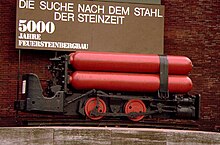Gas expansion engine
A gas expansion motor , also known as a compressed air motor , is a prime mover that is operated with compressed (compressed) gas (also known as compressed air).
How it works and uses
The workflow of a gas expansion engine corresponds to that of a steam engine ; both belong to the piston engines . The inlet valve opens and lets the high pressure gas into the expansion chamber ( cylinder ). After closing the inlet valve, the gas expands to the expansion end point. Typically, gas cools down in the process, i.e. H. its temperature sinks by itself. The ambient temperature is then usually higher than that of the gas, and the gas can absorb some heat, i.e. thermal energy, via the piston wall, which increases the yield (= mechanical energy per outlet pressure × compressed gas volume) somewhat. The gas flows out through the outlet valve with the required residual pressure. The motor can be designed as a single or double acting piston machine. Rotary pistons are also used in the low power range .
In the case of adiabatic expansion, the mechanical work emitted by the gas expansion motor originates integrally from the enthalpy stored in the gas . With isothermal expansion, the mechanical work released increases by the exergy absorbed .
Another way to reshape the enthalpy contained in the compressed gas into rotary motion, which offers vane motor .
From the end of the 19th century, gas expansion engines were built that were operated with carbon dioxide from pressure bottles. These so-called carbon dioxide motors were used to move turntable ladders , for example , and Otto Lilienthal experimented with them to drive his aircraft.
Gas expansion engines can be used as pressure regulators . The area of application for large gas expansion engines (> 5 kW) is energy recovery when extracting gas from gas pipelines .
The most common use is that of small gas expansion motors that are operated with compressed air and drive hand-held tools. The use of free-piston machines that work as pumps is also relatively common .
In principle, the gas expansion engine can also be used as a vehicle drive source, but in the past the amount of entropy that had to be carried in pressure vessels was so small and the overall efficiency so low that it was not economical to use. For a long time compressed air motors were only used as a drive for torpedoes .
Air motors were and are used in underground mining. In the rough, humid and dusty climate underground in the narrow tunnel, conductor lines and pantographs are difficult to implement. Flammable methane escapes in particular in coal mining. Methane and / or coal dust forms explosive mixtures with air, which must be protected from sparks such as those that occur in electrical circuits.
From the 1990s to around 2002 there were projects and announcements that there would be an air- powered vehicle ready for series production, the aircar . These announcements were renewed by a Luxembourg-based French company that announced that it would start producing the so-called OneCat from 2009. The announcement was not implemented.
literature
- Walter Gere: Compressed air motors. Row: How do I build myself? 132. Hermann Beyer, Leipzig, 2nd edition 1924 (with ill.)
See also
- Hot air engine
- Compressed air locomotive
- Gas turbine (rotation without piston)
Individual evidence
- ↑ Turntable ladders throughout history .
- ↑ Lilienthal's aircraft ( memento of the original from March 8, 2014 in the Internet Archive ) Info: The archive link was automatically inserted and not yet checked. Please check the original and archive link according to the instructions and then remove this notice. (PDF file).
- ↑ Tagesschau.de of January 3, 2008 ( Memento of October 13, 2008 in the Internet Archive )
Web links
- The rotary piston array machine
- Nothing but air in the tank ( Memento from October 13, 2008 in the Internet Archive )
